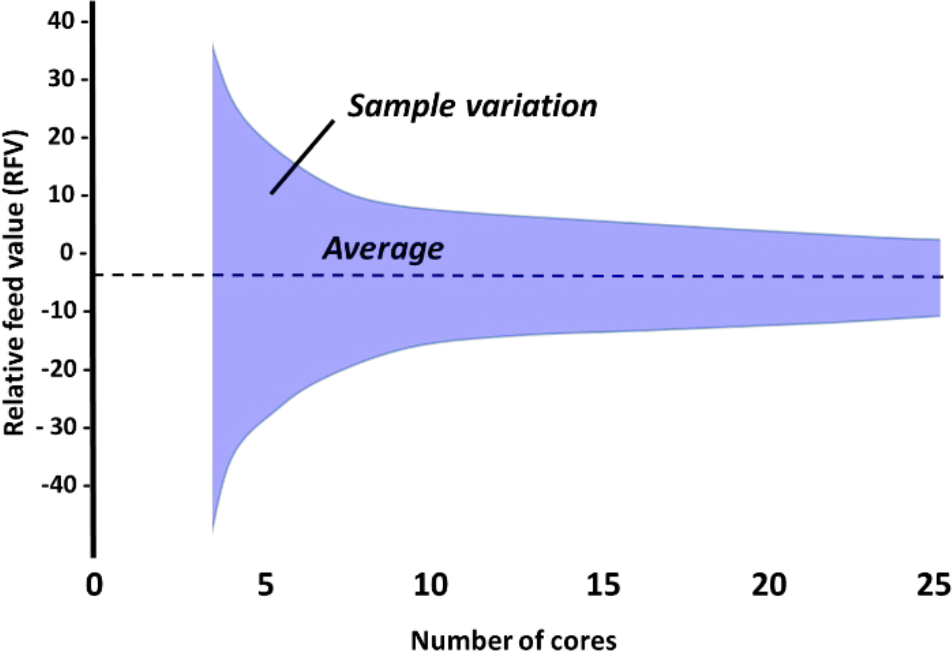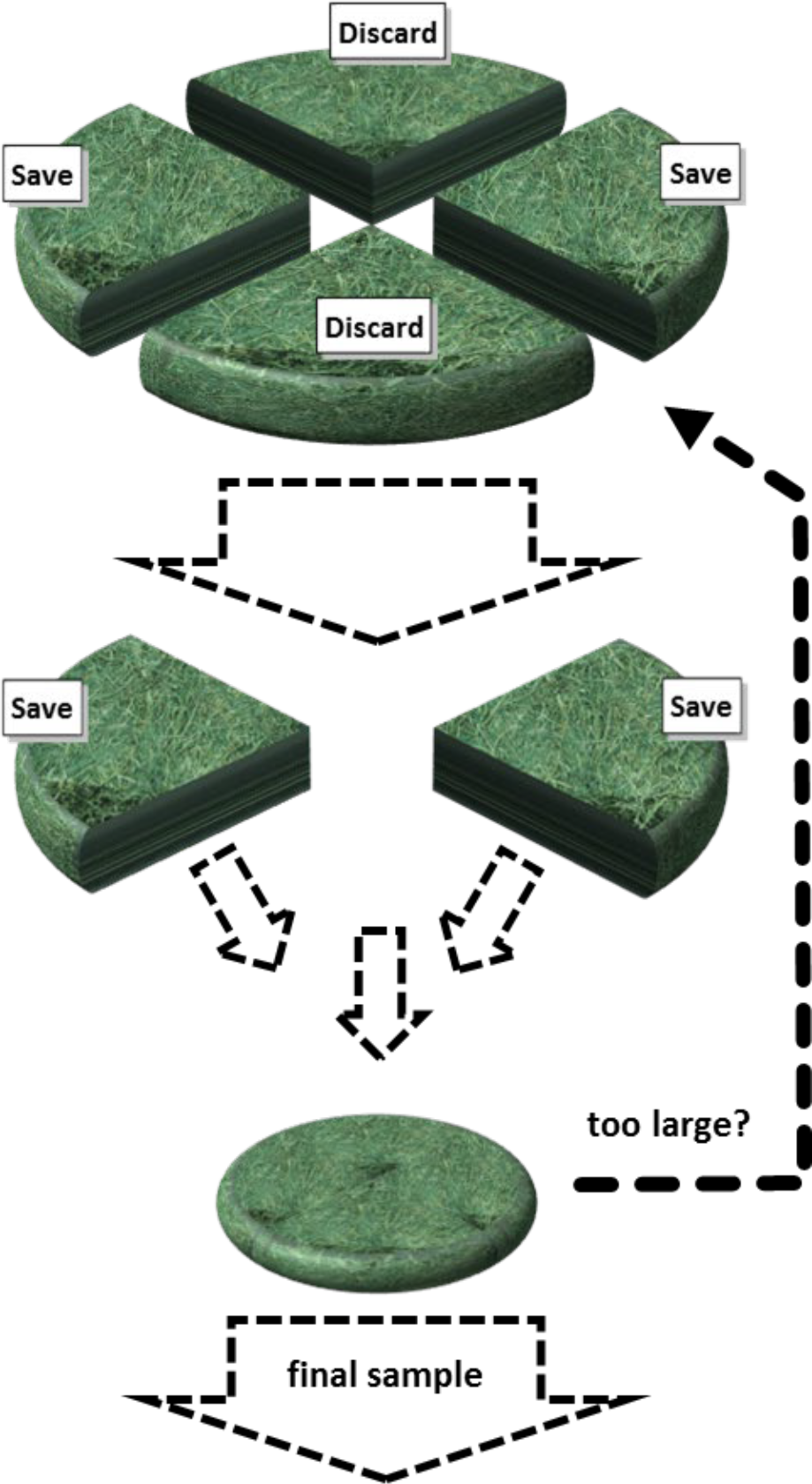⇦ Back to Livestock and Feedstuff Management Home
¶ Introduction
Different varieties, harvest times, or storage conditions cause variations in forage or feed quality. We use laboratory testing to identify these differences and balance rations properly. Representative feed samples are essential for accurate laboratory results. The following are recommended to help obtain those representative samples.
Also see the following Crop Files for more detail:
- 6.01.002 - Sampling Hay (forages and rations)
- 6.01.003 – Sampling Silage (forages and rations)
- 6.01.004 – Sampling Grains and Dry Feeds
¶ Basic Sampling Guidelines
- Use clean containers and sampling equipment
- Collect the proper number of subsamples for the type of feedstuff. Composite the subsamples to form the final samples
- Avoid transferring samples from one container to another more than necessary
- Avoid contaminating or mixing of samples with other feedstuffs
- Use plastic bags or containers. Plastic freezer bags are desirable. Paper containers are acceptable for very dry samples
- Use the “quartering” method to reduce sample size if necessary
- Label the container with name, address, sample ID, type of material, and test(s) requested
- Seal and secure the samples. Ship to the laboratory as soon as feasible
¶ Shipping
Ship samples by the most rapid means to prevent samples from molding or deteriorating in transit, which can affect nutrient content.
Refrigerate samples if they cannot be shipped immediately or store them in a cool location. Store samples by freezing if necessary, but it is better to ship samples promptly to the laboratory.
¶ Representative Samples
Each sample must represent only a single “lot” of a feedstuff or forage. The final sample should represent the entire “lot” of that feedstuff.
A “lot” of feed or forage is some quantity having uniform characteristics.
Feedstuffs from the same “lot” should be similar for:
- Type of plants, grains, or ingredients;
- growth in a single field or soil type;
- Maturity, cutting or harvest date;
- Varieties or mixtures;
- Type of harvest or harvest equipment;
- Weather during growth and harvest;
- Additives, supplements, preservatives;
- Conditions during curing and storages
- Uniformity is most important when defining a “lot”.
For example, a single forage “lot” is the total amount of a forage that was harvested from one field at the same cutting and maturity, likely within a 48-hour period.
Variation in any of these characteristics can cause substantial differences in feed value. Designate and sample a new “lot” of feed when these characteristics differ.
Avoid sampling moldy or decayed feeds that will be discarded or would likely be refused by animals when fed free choice. If necessary, sample problem feeds separately for specialized analysis. Contact the laboratory for sampling and shipping information.
¶ Sampling Tools
Samples should be collected in a clean container, like a plastic bucket. Samples should be mixed in the bucket or on a clean surface, like a plastic sheet or paper.
A hay probe that collects core samples is the best tool for sampling hay. Hand samples do not provide consistently reliable results. Sometimes, only a handful of leaves is collected. More often, leaves are stripped from the stem and left behind, so the sample contains an above-average amount of stems.
Silages and similar feeds can be sampled by hand. Do not squeeze or shake the hand-grab samples before placing them in the sampling bucket to avoid loss of fines.
A grain trier or bullet probe may be needed to sample grains or bulk feeds. Samples can be collected from a discharge spout using a stream sampler.
¶ Subsampling
The number of subsamples (cores, handfuls, etc.) that are collected during sampling is important because it affects the variability within the final sample.
The final sample should consist of a minimum of 12 to 15 subsamples if the “lot” is comparatively uniform. If the “lot” is expected to be more variable, then 15 to 20 subsamples are recommended.
Figure 1 illustrates how the relative variation changed with the number of subsamples (or cores). The shaded area indicates the degree of reliability. Variation decreased with more subsamples. The smaller the variation, the greater the accuracy of the analysis.
In this example, when only three cores were used for a sample, there is a 95% chance that the relative feed value (RFV) of an alfalfa hay will fall somewhere within a 72-point spread. That is a potential range of RFV values that are plusor-minus 36 points from the average.
Analyzing a sample made up of 20 cores reduced the potential spread of RFV results to a more reliable 14 points (plus-or-minus 7 points from the average).
¶ Figure 1. Sample Variation Based on Number of Subsamples (Cores)

¶ “Quartering"
A feed sample is sometimes too large and bulky to send to the laboratory. Obtain a smaller representative sample by “quartering” the larger sample.
Do not quarter the sample if separation of the ingredients will occur. Different size components of a mixed ration may segregate during mixing.
For example, leaves of dry alfalfa hay may shatter and be eliminated from the sample if it is quartered. Submit the entire sample for analysis if potential segregation may occur.
¶ Quartering Procedure:
- Mix the entire sample thoroughly
- Pour the mixed sample into a pile on a large piece of clean paper or plastic
- Carefully divide the pile into four equal parts or quarters (see Figure 2)
- Discard two of the opposite quarters
- Save and mix the two remaining quarters
- If the remaining sample is still too large for shipment, mix it thoroughly, and repeat the quartering procedure.The volume of the final sample should be about one quart to two quarts for forage-type samples; about one pint to one quart for grain-type samples
¶ Figure 2. Separate Sample Into Quarters; Save Two, Discard Two to Reduce Sample Size
